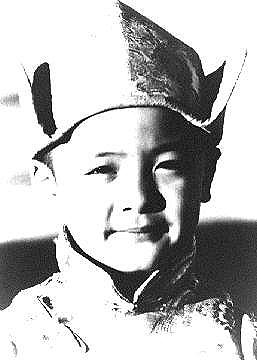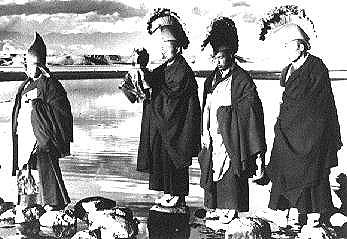

| Kundun: The Story behind the Story by Tim Richards. Tibet. To Western minds its name evoked a sense of wonder, of Shangri-La nestled in the tranquil mountains of the Himalayas. Not many would actually travel to it, but we were comforted to know it was there. In our increasingly complex modern life with its quickening pace, new technology and rampant consumerism, Westerners loved to think that somewhere there were cultures living in peace, serenity and simplicity, their Ying to our Yang. We'd never give it all up, but by God we liked to know that someone else could live without it all. And so Tibet lived on at the edge of our consciousness, a faraway place of simple ways and intriguing philosophies. |
 Movie Still, Kundun |
|
But the 20th Century proved ungentle to such romantic notions. Empires fell, monarchs toppled and many great established facts of the Western world crumbled to dust. The Second World War was the greatest pivot of change, breaking and re-forging the international order. For some it led to good, as developing countries broke free of their colonial chains. Other countries were not so fortunate. The faraway kingdom of Tibet was one of them. World War II defeated the fascists and liberated the colonies, but it also gave international communism its greatest surge forward this century. Added to the Soviet Union's 30-year example was half of Europe, some smaller Asian territories and the world's most populous country, China. In place of weak, divided governments of emperors and nationalists, China under Mao Zedong was a nation that commanded respect. With its vast population and acquisition of nuclear weapons, the new nation was a colossus intent on being involved in the world and mastering its own defence. Surrounded by potentially hostile neighbours, including newly independent India, China was intent on securing its BORDERs. In this context, Tibet could not be ignored. In 1950 the Red Army invaded Tibet, destroying its small, poorly-equipped army at Chamdo. By 1951 it had occupied Lhasa, though Tibet's spiritual and temporal head, the Dalai Lama, was allowed to remain in his palace as nominal leader of his people. This delicate peace lasted only briefly. In 1956 Tibetans in two regions started a revolt against Chinese rule, and three years later the whole country was in arms. 87000 Tibetans are said to have died in the revolt, and the Dalai Lama was forced to flee his country. |
 This is the backdrop to Kundun, a prelude to the suffering since experienced by Tibet through martial law, forced Chinese migration, destruction of temples, the chaos of the Cultural Revolution and man-made famine. The Dalai Lama has never been back to his country, but travels the world in promoting the cause of its independence. He is a symbol of independent Tibet that refuses to go away, and as such the Chinese leadership must long for the day he dies. That would cue the search for a newly-reborn Dalai Lama, only this time the Chinese government could interfere to its heart's content. The 14th Dalai Lama, whose biography is told in Kundun, is therefore a pivotal figure in Tibet's struggle. In many ways his story is the story of Tibet itself.
This is the backdrop to Kundun, a prelude to the suffering since experienced by Tibet through martial law, forced Chinese migration, destruction of temples, the chaos of the Cultural Revolution and man-made famine. The Dalai Lama has never been back to his country, but travels the world in promoting the cause of its independence. He is a symbol of independent Tibet that refuses to go away, and as such the Chinese leadership must long for the day he dies. That would cue the search for a newly-reborn Dalai Lama, only this time the Chinese government could interfere to its heart's content. The 14th Dalai Lama, whose biography is told in Kundun, is therefore a pivotal figure in Tibet's struggle. In many ways his story is the story of Tibet itself.It is hard to imagine the circumstances in which Tibet could become fully independent once more, short of a complete Soviet-style collapse of the central government in Beijing. This is not to admit hopelessness; it is well within the power of people and governments around the world to insist on Chinese respect for Tibetans' culture and human rights, and for Tibet to have some degree of autonomy in its affairs. This film's thought-provoking story is likely to continue that push.
See also: Kundun movie review by Narelle |
|
Like us on facebook |
No other uses are permitted without the prior written consent of owner. Use of the material in violation of the foregoing may result in civil and/or criminal penalties. Celebrate everything! www.festivale.info ISSN 1328-8008 Published in Melbourne, Victoria, Australia disclaimers | contact the editor | Festivale revision history  Published in Melbourne, Victoria, Australia Published in Melbourne, Victoria, Australia  copyright © Festivale 1998 All rights reserved copyright © Festivale 1998 All rights reservedFiled: 28-May-1998 Last tested: 3-Jul-2014 Entire site refreshed: Dec 2008-Feb 2009 | Site URL transferred: Jan 2005 (previously www.festivale.webcentral.com.au) |